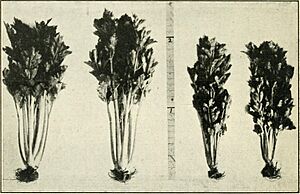Celery mosaic virus facts for kids
Quick facts for kids Celery mosaic virus |
|
|---|---|
| Virus classification |
|
| (unranked): | Virus |
| Realm: | Riboviria |
| Kingdom: | Orthornavirae |
| Phylum: | Pisuviricota |
| Class: | Stelpaviricetes |
| Order: | Patatavirales |
| Family: | Potyviridae |
| Genus: | Potyvirus |
| Species: |
Celery mosaic virus
|
| Synonyms | |
|
|
Celery mosaic virus (CeMV) is a tiny germ, like a cold for plants, that makes celery and other similar plants sick. It is a plant virus from the Potyvirus group.
People in California first noticed celery plants getting sick with "mosaic" diseases in 1922. At first, they thought it was one disease. But later, they realized there were at least two different viruses causing similar problems in celery.
Scientists learned to tell these two viruses apart by which plants they infected. One virus could infect many different plants. It was called Southern celery mosaic. The other virus only infected plants in the carrot family (called Umbelliferae or Apiaceae). This one was named Western celery mosaic.
Later on, they found out that Southern mosaic virus was actually a type of Cucumber mosaic virus. The Western celery mosaic then became known simply as Celery mosaic virus.
Contents
What are the symptoms of CeMV?
When a plant gets sick with Celery mosaic virus, you might see a few signs.
- The leaves can have a distinct mottled pattern, like a mix of light and dark green spots.
- Leaves might look twisted or crinkled.
- The plant might grow in a strange, bunched-up way (called "rosette formation").
- Older leaves can get yellow or brown spots.
- The whole plant might stop growing and stay small.
If a plant gets infected early in its life, it often won't produce good crops. But if it gets sick later, you might still get some usable celery if you harvest it quickly.
Which plants does CeMV infect?
As its name suggests, celery is the most common plant that gets sick from this virus. It causes the mosaic patterns and twisted leaves in celery.
Besides celery, this virus can also infect other important vegetables in the carrot family (Apiaceae). These include:
CeMV has also been found in several wild plants that are weeds, but are also in the carrot family. Examples include poison hemlock and wild cherry.
Where is CeMV found?
Celery mosaic virus is probably found all over the world. It has been reported in many places, including:
- North America: California and Florida in the USA, and Ontario in Canada.
- Europe: The UK, France, Germany, Italy, the Netherlands, and the former Czechoslovakia.
- South America: Argentina, Brazil, and Chile.
- Asia and Oceania: Japan, Australia, and New Zealand.
How does CeMV spread?
Celery mosaic virus is mainly spread by tiny insects called aphids. Aphids are like tiny plant vampires. When an aphid feeds on a sick plant, the virus can stick to its mouthparts (called a stylet). Then, when the aphid flies to a healthy plant and starts to feed, it can quickly transfer the virus.
The virus can also spread through tools and machinery. If a farmer uses a tool on a sick plant and then on a healthy one, the virus can be carried over.
Scientists know that at least 26 different types of aphids can spread this virus. However, there is no sign that the virus can spread through seeds.
How can we manage CeMV?
You can't really cure a plant virus with chemicals, just like you can't cure a human cold with antibiotics. So, managing Celery mosaic virus is all about stopping the aphids and preventing the virus from spreading.
Here are some ways farmers try to control CeMV:
- Planting resistant plants: Choosing types of celery that are naturally stronger against the virus.
- Spreading out crops: Planting celery fields further apart can help slow the spread.
- Clearing weeds: Removing weeds, especially those in the carrot family like wild celery or wild parsnip, helps reduce places where aphids can live and spread the virus.
- Pesticides: Sometimes, farmers use special sprays to reduce the number of aphids.
- Crop rotation: If a field has no celery or related plants for a few months, the risk of CeMV drops a lot.
- Reflective mulch: Some farmers cover the ground with shiny, reflective sheets (called mulch). This bright surface can confuse aphids and make them less likely to land on the plants, which helps reduce infections.
What is the genome of CeMV?
Scientists have studied the complete genetic code of Celery mosaic virus. This code, called a genome, is like a long instruction manual for the virus. It was fully mapped out in 2011. The genome is made of about 9,999 tiny units called nucleotides. These units contain the instructions for the virus to make its proteins.
Scientists compare the CeMV genome to other viruses to understand how they are related. CeMV shares some similarities with other viruses in the Potyvirus group. It is most closely related to a virus called Apium virus Y.


